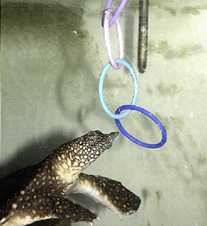SCANDINAVIAN researchers
have identified five genes in Nova
Scotia duck tolling retrievers
which appear to be responsible for
the high incidence in the breed of
the autoimmune condition
systemic lupus erythematosus.
The discovery demonstrates the value of pedigree dogs in research on the causes of complex multi-gene conditions and boosts the prospects
for developing improved treatments
for similar conditions in humans and
dogs.
The combined Swedish-Finnish
team from the universities of
Uppsala and Helsinki report their
findings in the online version of
Nature Genetics (www.nature.com/ng/index.html).
They located gene loci in 81
affected dogs which were absent
from 57 healthy controls. Three sites
predispose the dogs to a SLE like
condition, characterised by joint
damage and inflammatory signs in
various internal organs, while two loci
are linked both to SLE and another
immune-mediated condition, steroid-
responsive meningitis-arthritis.
Professor Hannes Lohl, head of
the canine genetics research group at
Helsinki, said the ability to identify
equivalent conditions in dogs made
them a valuable model for studies of
human disease.
“Although we plan to identify and
characterise the functions of the
canine mutations, this study opens
the door for further studies of
specific T-cell activation pathways in
human populations.
“In the longer term, the
development of clinical treatment
regimens based on a dog’s particular
risk genotype might be possible. For
instance, the effect of calcineurin
inhibitors (such as the
immunosuppressant drug
cyclosporin) could be studied in dogs
as a complement or alternative to
traditional corticosteroid therapy.
“Such studies might also lead to
better treatment options for human
rheumatic diseases and SLE,”
Professor Lohl said.
The Nova Scotia duck tolling
retriever was developed in the
Yarmouth region of Nova Scotia in
the early 1800s as a hunting and
retrieving dog. The modern breed is
descended from a very small
population of dogs that survived two
devastating outbreaks of canine
distemper virus in 1908 and 1912.
It has been suggested that the
unusually high incidence of
autoimmune diseases in the breed is
due to the fact that dogs with
particularly strong or reactive
immune systems were much more
likely to survive these outbreaks.






